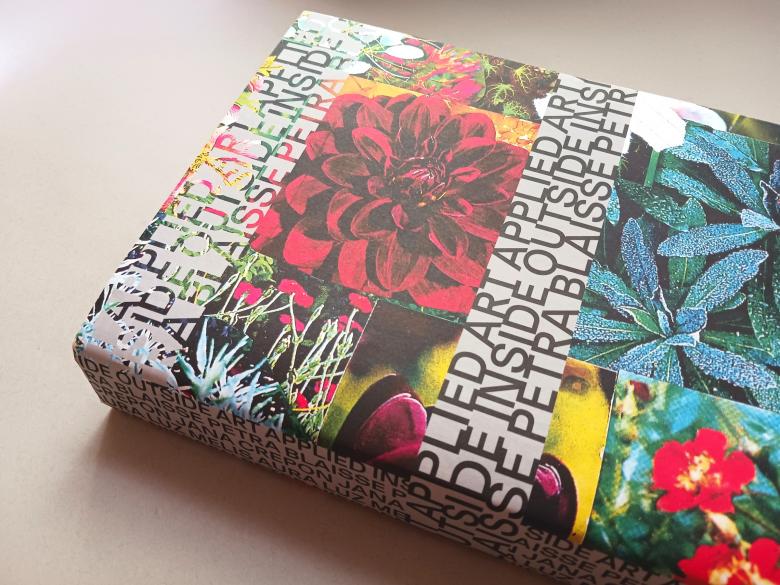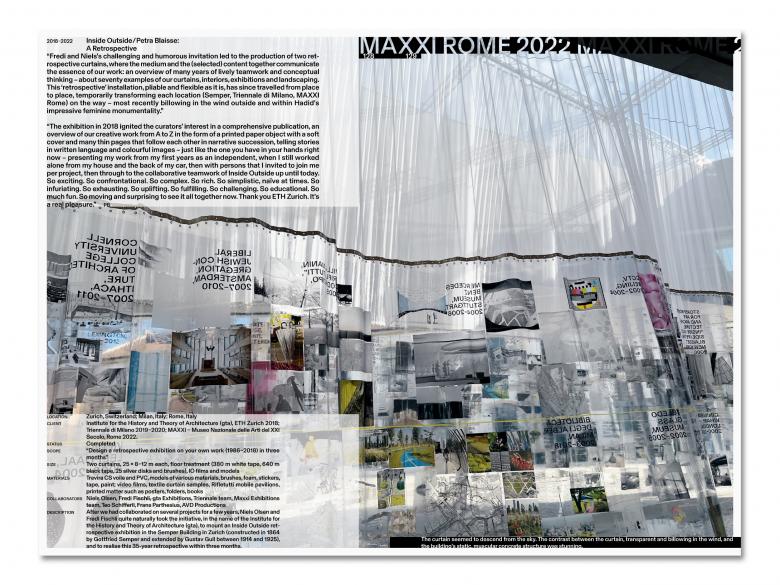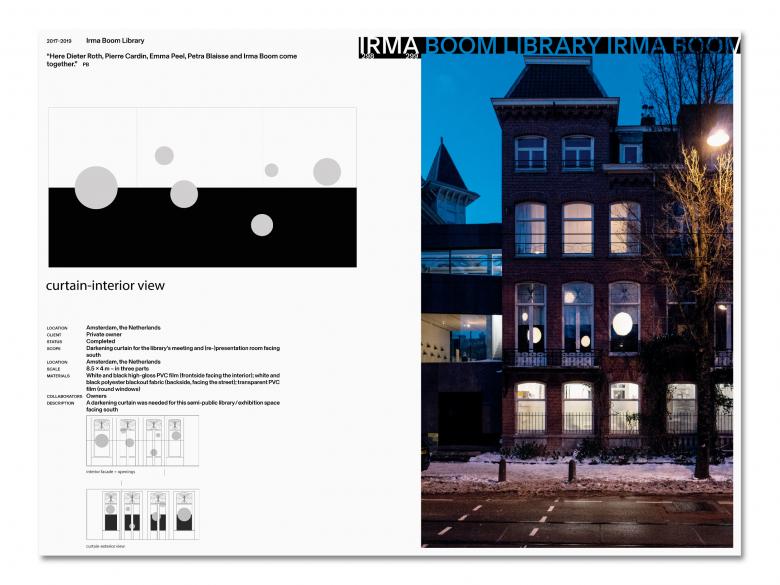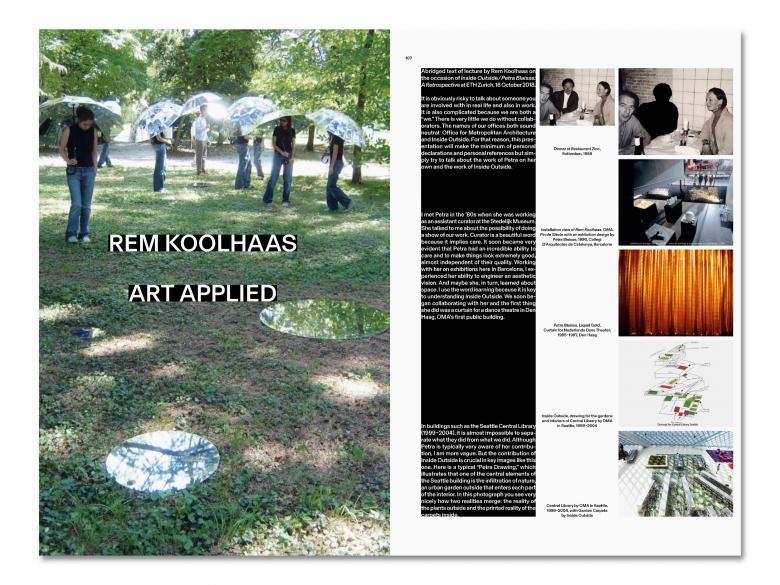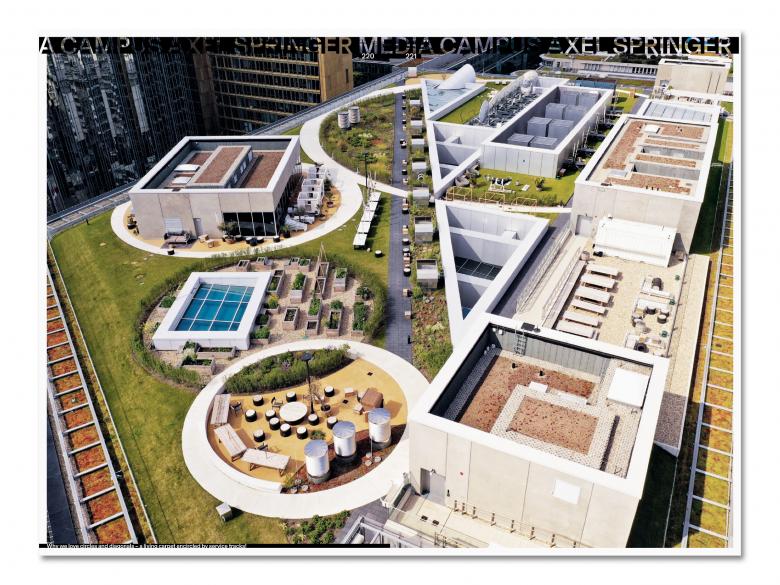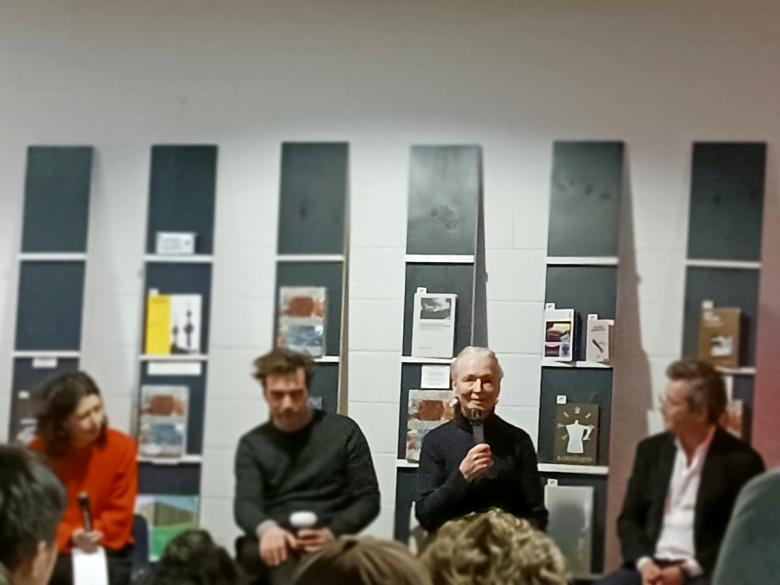Four years in the making, Art Applied is the third and latest book by Petra Blaisse on her Amsterdam design studio Inside Outside. Clocking in at nearly 900 pages and cloaked in a dust jacket that doubles as a poster, the book is as close to a comprehensive document of the career of a designer who is known for curtains but also designs exhibitions and landscapes. Our review.
A standing-room only crowd greeted Petra Blaisse at Head Hi, an architecture and design bookstore in Brooklyn's Fort Greene neighborhood, on Monday night to hear her speak about Art Applied, published this month by MACK. The Dutch designer was not alone; she was accompanied by Fredi Fischli and Niels Olsen, co-directors of exhibitions at the Institute of the History and Theory of Architecture (gta) at ETH Zurich and editors of the book, and Cecily Brown and Nicolai Ouroussoff, the artist and architecture critic, respectively, who are also married and a client of Inside Outside. Blaisse's partners at Inside Outside, Jana Crepon and Aura Luz Mells, were also in attendance for the book launch.
It was a great conversation, sometimes humorous but always illuminating, especially in regard to the book's origins. Art Applied can be traced back to 2018 and the gta exhibition on Petra Blaisse / Inside Outside that Fischli and Olsen curated. Instead of using the small, glass-walled gta gallery at ETH's Hönggerberg campus, Inside Outside / Petra Blaisse: A Retrospective took over the central hall of the historic main building on ETH's Zentrum campus. The setting was appropriate, not only due to its size and scale, but because the building was designed by Gottfried Semper, the 19th-century German architect and dean of the architecture school at ETH who “argued that architecture is based on low decorative arts,” the curators/editors write in the introduction to Art Applied, “and borrows from crafts such as pleating and weaving.” Fittingly, Blaisse's studio displayed their projects on two immense curtains hung within the large colonnaded hall. Although site-specific, the curtains were subsequently sent to Milan for the Triennale in 2019 and then, following the pandemic, to MAXXI in Rome in 2022.
The idea of a book began with the 2018 exhibition, with Fischli and Olsen thinking optimistically, and perhaps with a bit of naiveté, that they could turn the presentation of seventy Inside Outside projects on two curtains into one book: “We could just print it,” Fischli admitted at Head Hi, “and then it would become the book.” The reality of the project, which would take four years, was much more complicated — as most book projects are. For one, the projects were printed on transparent curtains, so people could look at the projects on either side of the curtains and see through to people on other side. The exhibition also included films because, as Blaisse explained during the conversation, “our work is all about movement and time, issues of time: living and dying, waking up again in the spring.”
Although the transparency of the curtains and the movement of the films could not be translated directly into book form, Art Applied does an excellent job of presenting the diverse and voluminous output of Inside Outside over the course of nearly 40 years. Some of this success can be attributed to the design of Teo Schifferli, who uses text sparingly but effectively in the project presentations and uses photographs, sketches, drawings, film stills, and other images in a way that gives each project equal weight, be they curtains, a landscape, or some other project type. Schifferli's involvement is somewhat surprising, given that Blaisse's first two books — Movements 25%: Introduction to a Working Process, the catalog for an exhibition at the Storefront for Art and Architecture in New York in 2000; and the eponymous Inside Outside | Petra Blaisse, published by NAi and Monacelli in 20007 — were designed by Irma Boom, the bookmaker also based in Amsterdam.
Boom, it turns out, was a client of Blaisse's. Her library, for which Blaisse designed a “darkening curtain for the library's meeting and (re-)presentation room facing south,” is found starting on page 298 in the book's reverse chronological presentation of selected projects. This presentation method means that the selected projects begin near the present, on page 128, with the exhibitions in Zurich/Milan/Rome, and end in 1987, on page 873, with the stage curtain and other interior elements for the Nederlands Dans Theater in The Hague. The latter — that is to say the earlier — project is notable as Blaisse's first project as an independent designer, coming after years working as an assistant at the Stedelijk Museum in Amsterdam, but also as the first major commission for Rem Koolhaas and OMA. (Regardless of these markers of note, the building was demolished without protest in early 2016.)
Koolhaas, a longtime collaborator with both Boom and Blaisse, was the proverbial elephant in the room at Head Hi on Monday night: Blaisse and Koolhaas have a personal relationship that is familiar enough to be on both of their Wikipedia pages, but his name was said just once during the book launch and their private lives do not enter into the pages of the monograph, even though OMA projects are in abundance. Koolhaas, in the transcript of a 2018 lecture at the ETH that leads into the presentation of projects in the book, even says: “It is obviously risky to talk about someone you are involved with in real life and also in work. […] For that reason, this presentation will make the minimum of personal declarations and personal references but simply try to talk about the work of Petra on her own and the work of Inside Outside.” Much as the book does.
Koolhaas also says of Blaisse that “we are both a ‘we.’ There is very little we do without collaborators.” Indeed, their collaborations are many but, more importantly, notable. Take away Blaisse's contributions and numerous OMA projects lose the pieces that make them recognizable or even seminal — pieces that make them total environments, from the hard concrete and steel down to colors on the walls and the floors and the curtains that can change a space at the push of a button. There's the Liquid Gold curtain at the Nederlands Dans Theater, but also the color scheme for Taipei Performing Arts Center (2022), the Garden Carpets at the Seattle Public Library (2005), the billowing curtain of Maison Bordeaux (1998/2012), and the spiraling curtain at the Kunsthal Rotterdam (1992), among others.
The most interesting anecdotes on Monday evening involved some of these or other OMA projects. The Kunsthal Rotterdam, for instance, was an example of how innovative Blaisse's curtains can be, how they can do more than divide or open space depending on their position. She designed the Kunsthal's auditorium curtain so it would resemble an inclined column when stored, but also, in collaboration with James Rubery, she integrated speakers into the curtain so the space formed by the fabric was also acoustic. But, as she recounted, “they replaced it twice and forgot to ask us, so the speakers are no more.” So the project also becomes a symbol of the ephemeral nature of curtains, of textiles, something Blaisse is more than aware of and accepting of in her movement- and time-based work.
In another story, Blaisse told of making a giant “sock” for the Prada Epicenter, OMA's high-budget reconceptualization of the shopping experience that opened in New York's SoHo neighborhood in 2001. Conceived to cover a large column of speakers suspended from the ceiling, the sock was knitted by Blaisse and her assistant in a room at the Gramercy Park Hotel ahead of the store's opening, a feat that involved stuffing the fabric shipped from Germany into the hotel's elevator, using DIY knitting needles made from sticks and garden hose, watching bad American TV for seven days, dumping the finished product out the window into a cab, and getting the sock into place with just minutes to spare.
This Prada story is also described by Blaisse in Art Applied — likely one reason she could recite it in such detail on Monday — as indicated by a “PB” at the end of the project description. Most of the texts for the many projects in the book are in Blaisse's voice, and this is another element — in addition to the design and the overall quality of the projects — that makes the book so good. Blaisse is honest, open, and intimate with her texts, making them informative but also entertaining, a bit like having a conversation with her about her studio's work.
Lastly, why Art Applied, why that title? “I come from an art background,” Blaisse said on Monday, “so I'm not an architect and I'm not a landscape architect,” even though her projects are integral with architecture and gardens are one of the typologies she works within. Koolhaas, in the ETH lecture transcript, calls Blaisse an “applied artist,” saying such a person is “the opposite of a designer,” because an artist does not need to solve certain issues or please a certain audience. Instead of working within the confines of galleries and other art settings, an applied artist “engages with the world outside the museum.” For Blaisse, that “world outside” is a house, a theater, an apartment building, a library, a garden, the roof of an office building, or even a museum. Just as the name of her studio refers to their work bridging the realms of inside and outside, Art Applied finds Inside Outside's abilities to span art, architecture, design, and landscape on full display.

Art Applied
Inside Outside / Petra Blaisse
Edited by Fredi Fischli and Niels Olsen, designed by Teo Schifferli
18 x 27cm
896 Pages
Paperback with french-fold jacket
ISBN 9781915743343
MACK
Purchase this book
